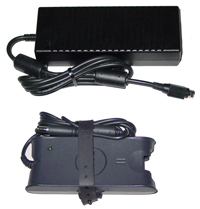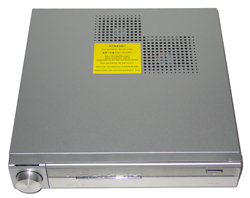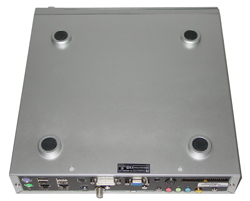Asus DigiMatrix - The Pizza Box Form Factor
by Andrew Ku on February 11, 2004 1:41 PM EST- Posted in
- Systems
Construction - Build, Appearance, Size (continued)
The sides of the DigiMatrix are bare, each side only revealing a large strip of ventilation holes that serve as intake vents. This is mainly because it functions as a PC and therefore, has PC components, such as memory, a CPU, a hard drive, etc., all of which need to be cooled.The back side of the system is home to most of the functionality of the DigiMatrix. In the upper left hand corner are the ports from the audio/radio module: antenna jack, line in, headphone, and microphone. Next is a RF connector for the TV input, video in, 10/100 ethernet jack, Gigabit ethernet jack, USB 2.0 ports, and the PS/2 ports (keyboard and mouse). For video output, the DigiMatrix provides three options: VGA, LCD, and HDTV/TV.
In the lower left hand corner is the second channel IDE connector of the motherboard. The hard drive (you need to buy) and the bundled optical drive run off the primary channel. This is for the DigiMatrix subsystem, which is an additional accessory you will need to purchase, should you want to add a second hard drive and optical drive. We don't have that many details on the subsystem, but it follows the same basic layout as the DigiMatrix, just without the motherboard and accessories. The only thing that it contains is the space to add a hard drive (not provided) and the notebook-size optical drive that comes with the subsystem. This seems to suggest that the subsystem is similar (if not smaller) than the footprint of the DigiMatrix.
To the right of the IDE connector is the 3-pin power connector, which goes off to the power brick. The small power port next to the 3-pin power connector is actually a power out feed for the subsystem. This is so that the subsystem doesn't need the hassle of another power adapter. Unfortunately, this means that the DigiMatrix will need a bigger power brick to accommodate the extra possible power drain.
There are two square exhaust vents on the top side for the only two system fans. The bottom side is bare, minus the four rubber feet.
Because the DigiMatrix has a pizza box like form factor, it only measures 11.2" x 11.4" x 2.1" thick. This makes it basically the same size as the many of the DVD players on the market. Fully loaded (CPU and hard drive added), the DigiMatrix weighs somewhere between 8 and 9 pounds. Its weight class makes it comparable to one of the high-end desktop replacement notebooks.

Click to enlarge.
DigiMatrix's power brick next to the Dell Inspiron 8600's power brick.
The power brick for the DigiMatrix is manufactured by Lite-On, and it is probably one of the biggest final production bricks that we have seen on any PC, notebook and SFF alike. Our eventual hope is that the power brick size would decrease in the second generation of the DigiMatrix model.















16 Comments
View All Comments
mindless1 - Thursday, February 12, 2004 - link
LOL, it's just wastefull to design a box big enough for RAID 0+1, and MPEG2 certainly does not need (even) modern HDD performance levels.It was a nice review, but I'd have to disagree with one part- It is not desirable to decrease the size of the power supply. Make it too small and it's going to have high heat density, lower reserve capacity, and overall less quality in the design. It IS possible to use very high quality and more exotic parts to decrease size, at about 3X the cost.
I agree that it would be very nice if the remote had a touchpad on it, similar to that on a notebook.
One thing I wish Asus had done differently, is to find a way to make more of the front panel ports, or at least the DVD tray, accessible without opening that front hatch. I imagine my hatch would always stay open just so I didn't have to open/close for something as simple as loading a DVD.
Doormat - Wednesday, February 11, 2004 - link
I've been looking at SFF/HTPC like boxes, but my biggest gripe is that they only have 1 or 2 spots for a hard drive. When I build a HTPC, I'd want more than 2 HD spaces (preferably 4 SATA connectors w/ bays). That prolly wont make it a SFF box, but a Tivo-size box could provide for that. The idea is that 4x200GB in RAID 0+1 would provide enough for recording TV in HD/SD MPEG-2 as well as ripping DVDs and storing them, plus other misc stuff. None of the products on the market can suit me and look nice...AlabamaEnigma - Wednesday, February 11, 2004 - link
It's not a bad little box, but I prefer their new T2-P Deluxe. It has MOST of the features of the DigiMatrix, but uses the i865G chipset and has 8X AGP. It's also a lot cheaper.3Suns - Wednesday, February 11, 2004 - link
It doesn't come with a hard drive, processor, or memory. It's a barebones system. And the 533 MHz refers to the FSB.for $400 I actually think it's kind of a bargain. Nice case with a volume knob and case buttons and an LCD, motherboard, video capture card, radio tuner, tv tuner, gigabit ethernet, wireless ethernet, DVD/CD-RW, separately powered MP3 player, 7-in-1 card reader...
I'm seriously considering putting together a sub-$1000 system and trying to get it running as a personal Linux fileserver/media station. Wish me luck!
ChemMan - Wednesday, February 11, 2004 - link
I think by 533 Mhz they mean the fsb, not the clock speed of the processor.Jeff7181 - Wednesday, February 11, 2004 - link
Am I reading this right?It doesn't come with a hard drive? Not even a tiny little 20 or 40 GB drive to get someone started using it as a Tivo type of thing? For $400 the least they can do is stick a little 20 GB 5400 RPM hard drive in there... sheesh.
Call me crazy, but shouldn't you be able to passively cool a 533 Mhz Pentium 4? I mean... a Pentium 4 @ 533 Mhz is probably creating what... 10-15 watts of heat? I was shocked to see what looks like a heatpipe and two large fans in there... looks like a very poor cooling design to me.